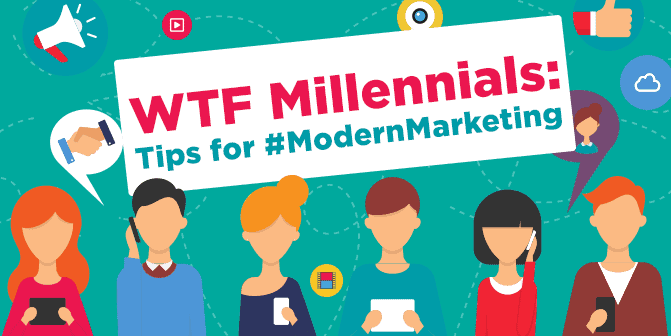Generations are extremely broad—they homogenize vastly different people, values, interests, experiences based on having a birthday that falls within a 15 year range. Yup, not every Millennial is a mustachioed, plaid-wearing, PBR-drinking hipster—just like every Baby Boomer isn’t a crochety budget hunter who doesn’t know how to use a computer. Shocking, we know.
People like to think of themselves as individuals, not as demographics. Still, there are some common experiences and traits among members of different age groups that can be used to help you develop your marketing strategies when targeting these people as consumers. The Internet allows even those CMOs with modest budgets to pursue differentiated marketing techniques.
So how can you do that? What do you need to know to market your business to members of the Millennial, Gen X, and Baby Boomer Generations? You’ve come to the right place to find out!
Millennials were born between 1981 and 1995. They’ve also been called the “Me Generation” or “Generation Google,” because this is the first group of people who grew up with social media, Google, and widespread Internet use. They’re used to quick responses, personalized results, and new technology.
Marketing to this generation can be tricky, because they’re much more wary of traditional marketing than their predecessors. Still, with some finesse and a few of our tricks, you’ll be well on your way to nabbing this coveted demographic.
Use word of mouth to your advantage.
This young crowd also overwhelmingly trusts word-of-mouth buzz more than customary marketing. 95 percent of them say they prefer friends’ opinions over traditional advertising. Make reviews a large feature of your service or product page to leverage the Millennials’ need to conduct independent research and find testimonials from unbiased sources. Yelp and other review sites are major for any business targeting this audience—businesses have been built and destroyed by the power of the social review. Monitor your business’ page for any negative review, respond politely, and try to correct any mishaps (but carefully, as you don’t want to seem like you’re pandering). Similarly, intermittently rewarding positive reviews can reinforce brand loyalty to those already doing the heavy lifting for your digital marketing efforts.
Find them where they are.
With that in mind, a savvy marketer will meet Millennials in the spaces they gather online, listen to their conversations, and create organic, two-way dialogues. The right way to do this is to talk about yourself or your business only about 20 percent of the time—and to do so in ways that will create value for the audience by entertaining or educating. (Keep in mind that Millennials share memes and GIFs more than any other generation!) Encourage your customers to submit user-generated content through contests or discounts.
The three most consumed types of content by this age group are blog posts, images, and comments. Content marketing is a great way to build a reputation for being useful to this demographic.
Sell the experience, not the stuff.
Another unique thing about the Millennial demographic is that they value experiences over possessions. They don’t buy cars as often as they take an Uber; their music collections are digital playlists rather than stacks of CDs. To strike a chord, emphasize the feelings and events associated with your product. After all, Nike doesn’t sell sneakers; it sells athletic prowess.
To leverage this generational shift, ask yourself these vital questions:
- How does my product empower the consumer? Figuring out exactly what your clients do with your product is important, obviously. Bonus points if it enables them to feel in command of their data, their skills, or their life.
- How does my product help build a community? Millennials are more invested in socially conscious brands— ones that connect them to other people, either directly or indirectly. Warby Parker not only sells great eyeglasses, but they also donate a pair to a person in need with each purchase. Why would your client brag about your business to her friends? Capitalize on that.
- What does my product say about its buyers? Owning a Prius says you’re environmentally conscious and socially aware. A Mac says you’re artistic and sensitive. These labels might not be true, but the images are driving consumption as much or more than the differences between of horsepower or RAM.
As Josh Dykstra wrote for Fast Company:
Today, a product or service is powerful because of how it connects people to something—or someone—else. It has impact because we can do something worthwhile with it, tell others about it, or have it say something about us.
Go mobile or bust.
Millennials have spent their entire adult lives using smartphones, and they’re early adopters to new technology. To reach them, it’s imperative for companies to optimize their websites for mobile viewing. A whopping 52 percent of Millennials use their phones as their primary web-viewing device. Since Google is already punishing sites that don’t include responsive design, there’s no better time than now ensure you can attract and keep this demographic. Similarly, creating a popular hashtag, app, or check-in campaign can be rewarding.
Demographics are a major predictor of buying behavior, but they aren’t failsafe. The more you can learn about your clients—whether from social media data or comment cards—the better you can directly tailor your marketing strategy to them. If you need help targeting your digital marketing to your audience, contact us here at Zen Media today.





